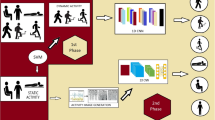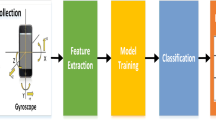Abstract
The research on human activity recognition has provided novel solutions to many applications like health care, sports, and user profiling. Considering the complex nature of human activities, it is still challenging even after effective and efficient sensors are available. The existing works on human activity recognition using smartphone sensors focus on recognizing basic human activities like sitting, slee**, standing, stair up and down, and running. However, more than these basic activities is needed to analyse human behavioural pattern. The proposed framework recognizes basic human activities using deep learning models. Also, ambient sensors like PIR, pressure sensors, and smartphone-based sensors like accelerometers and gyroscopes are combined to make it hybrid sensor-based human activity recognition. The hybrid approach helped derive more activities than the basic ones, which also helped derive human activity patterns or user profiling. User profiling provides sufficient information to identify daily living activity patterns and predict whether any anomaly exists. The framework provides the base for applications such as elderly monitoring when they are alone at home. The GRU model’s accuracy 95% is observed to recognize the basic activities. Finally, Human activity patterns over time are recognized based on the duration and frequency of the activities. It is observed that human activity pattern, like morning walking duration, varies depending on the day of the week.
















Similar content being viewed by others
References
Liu J, Liu H, Chen Y, Wang Y, Wang C. Wireless sensing for human activity: a survey. IEEE Commun Surv Tutor. 2019;22(3):1629–45.
Bianchi V, Bassoli M, Lombardo G, Fornacciari P, Mordonini M, Munari ID. Iot wearable sensor and deep learning: An integrated approach for personalized human activity recognition in a smart home environment. IEEE Internet Things J. 2019;6(5):8553–62. https://doi.org/10.1109/JIOT.2019.2920283.
Ranjit Kolkar GV. Human activity recognition in smart home using deep learning techniques. In: 2021 13th international conference on information & communication technology and system (ICTS). IEEE; 2021. p. 230–234.
Qiu H, Wang X, **e F. A survey on smart wearables in the application of fitness. In: Proceedings of IEEE 15th international conference dependable, autonomic and secure computing. IEEE 15th international conference on pervasive intelligence and computing. IEEE 3rd international conference on big data intelligence and computing, Orlando, FL, USA; 2018. p. 303–307.
Zainudin MNS, Sulaiman MN, Mustapha N, Perumal T. Monitoring daily fitness activity using accelerometer sensor fusion. In: International Symposium on Consumer Electronics (ISCE), Kuala Lumpur, Malaysia; 2017. p. 35–36.
Zainudin MNS, Sulaiman MN, Mustapha N, Perumal T. Monitoring daily fitness activity using accelerometer sensor fusion; 2017. p. 35–36.
Ahmadi A, et al. Toward automatic activity classification and movement assessment during a sports training session. IEEE Internet Things J. 2015;2(1):23–32.
Mora N, Bianchi V, Munari ID, Ciampolini P. A bci platform supporting aal applications. In: Stephanidis, C, Antona, M, editors. Universal access in human–computer interaction. Design and development methods for universal access. UAHCI 2014 (LNCS 8513). Springer, Cham, Switzerland; 2014.
Ancans A, Rozentals A, Nesenbergs K, Greitans M. Inertial sensors and muscle electrical signals in human–computer interaction; 2017. p. 1–6.
Qiu S, Wang Z, Zhao H, Liu L, Jiang Y. Using body-worn sensors for preliminary rehabilitation assessment in stroke victims with gait impairment. IEEE Access. 2018;6:31249–58.
Bisio I, Delfino A, Lavagetto F, Sciarrone A. Enabling iot for in-home rehabilitation: accelerometer signals classification methods for activity and movement recognition. IEEE Internet Things J. 2017;4(1):135–46.
Rabbi J, Fuad M, Hasan T, Awal M. Human activity analysis and recognition from smartphones using machine learning techniques. 2021. ar**v:2103.16490.
Weiss GM. Wisdm smartphone and smartwatch activity and biometrics dataset. UCI Mach Learn Repos WISDM Smartphone Smartwatch Act Biom Dataset Data Set. 2019;7:133190–202.
Ranjit Kolkar GV. Issues and challenges in various sensor-based modalities in human activity recognition system. In: Applications of advanced computing in systems: proceedings of international conference on advances in systems, control and computing; 2021. Springer. p. 171–179.
Trung TQ, Lee NE. Flexible and stretchable physical sensor integrated platforms for wearable human-activity monitoring and personal healthcare. Adv Mater. 2016;28(22):4338–72.
Kwapisz JR, Weiss GM, Moore SA. Activity recognition using cell phone accelerometers. In: Proceedings of the fourth international workshop on knowledge discovery from sensor data (at KDD-10), Washington DC; 2010.
Anguita D, Ghio A, Oneto L, Parra X, Reyes-Ortiz JL, A public domain dataset for human activity recognition using smartphones. In: 21th European symposium on artificial neural networks, computational intelligence and machine learning, ESANN 2013, Bruges, Belgium; 2013.
Reiss A, Stricker D. Introducing a new benchmarked dataset for activity monitoring. In: The 16th ieee international symposium on wearable computers (ISWC); 2012.
Ramanujam E, Perumal T, Padmavathi S. Human activity recognition with smartphone and wearable sensors using deep learning techniques: a review. IEEE Sens J. 2021;21(12):13029–40.
Lee ML, Dey AK. Sensor-based observations of daily living for aging in place. Pers Ubiquit Comput. 2015;19:27–43.
Shibuya N, Nukala BT, Rodriguez AI, Tsay J, Nguyen TQ, Zupancic S, Lie DY. A real-time fall detection system using a wearable gait analysis sensor and a support vector machine (svm) classifier. In: 2015 eighth international conference on mobile computing and ubiquitous networking (ICMU); 2015. IEEE. p. 66–67.
Attal F, Mohammed S, Dedabrishvili M, Chamroukhi F, Oukhellou L, Amirat Y. Physical human activity recognition using wearable sensors. Sensors. 2015;15(12):31314–38.
Kumar P, Chauhan S. Human activity recognition with deep learning: overview, challenges possibilities. CCF Trans Pervasive Comput Interaction. 2021;339(3):1–29.
Ranjit Kolkar GV. Human activity recognition using deep learning techniques with spider monkey optimization. Multimed Tools Appl. 2023;1573–7721:1–18.
Hailemariam E. Proceedings of the 2011 symposium on simulation for architecture and urban design. In: Society for computer simulation international. 2011.
Anguita D, Ghio A, Oneto L, Parra X, Reyes-Ortiz JL. A public domain dataset for human activity recognition using smartphones. In: 21th European symposium on artificial neural networks, computational intelligence and machine learning, ESANN 2013, Bruges, Belgium; 2013. p. 24–26.
Chavarriaga R, Sagha H, Calatroni A, Digumarti ST, Tröster G, Millán JDR, Roggen D. The opportunity challenge: A benchmark database for on-body sensor-based activity recognition. Pattern Recognit Lett. 2013;34(15):2033–42.
CASAS Dataset. 2020. http://casas.wsu.edu/datasets/.
Biel J, Gatica-Perez D, Prendinger H. The ExtraSensory dataset: a benchmark for continuous contextual sensing. In: Proceedings of the 2015 ACM international joint conference on pervasive and ubiquitous computing; 2015. p. 415–418. https://doi.org/10.1145/2800835.2804332
Sucar LE, Morales EF. Sisfall: a fall and movement dataset. Sensors. 2016;16(8):1344. https://doi.org/10.3390/s16081344.
Altun K, Barshan B, Tunçel O. Comparative study on classifying human activities with miniature inertial and magnetic sensors. Pattern Recogn. 2010;43(10):360.
Kuhlmann T, Garaizar P, Reips U-D. Smartphone sensor accuracy varies from device to device in mobile research: the case of spatial orientation. Behav Res Methods. 2021;53:22–33.
Author information
Authors and Affiliations
Corresponding author
Ethics declarations
Conflict of interest
On behalf of all authors, the corresponding author states that there is no conflict of interest.
Additional information
Publisher's Note
Springer Nature remains neutral with regard to jurisdictional claims in published maps and institutional affiliations.
This article is part of the topical collection “Research Trends in Communication and Network Technologies” guest edited by Anshul Verma, Pradeepika Verma and Kiran Kumar Pattanaik.
Rights and permissions
Springer Nature or its licensor (e.g. a society or other partner) holds exclusive rights to this article under a publishing agreement with the author(s) or other rightsholder(s); author self-archiving of the accepted manuscript version of this article is solely governed by the terms of such publishing agreement and applicable law.
About this article
Cite this article
Kolkar, R., Geetha, V. Human Activity Behavioural Pattern Recognition in Smart Home with Long-Hour Data Collection. SN COMPUT. SCI. 4, 864 (2023). https://doi.org/10.1007/s42979-023-02278-y
Received:
Accepted:
Published:
DOI: https://doi.org/10.1007/s42979-023-02278-y




